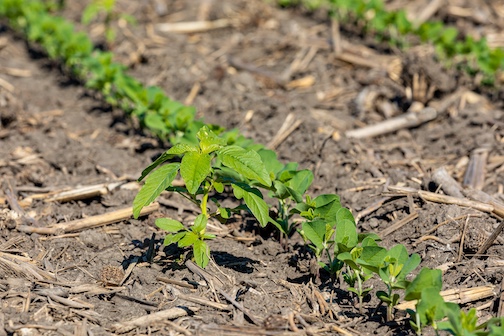Timing is Just About Everything for Post-Emerge
May 28, 2025

“In post-emerge herbicide applications, timing is imperative,” said Brad Hipsag, Federated ag sales rep out of Ogilvie. Crops don’t like weeds that compete for nutrients, moisture, and sunlight.
Post-emerge applications should be done when weeds are no taller than 4 inches, Hipsag noted. “The herbicide is more effective, and the weeds are much easier to kill,” he said. Bigger weeds are already robbing yield – and they are harder to take down.
Scout now – and later – for weed species, densities, and heights.
Soybeans that received a pre-emerge application need to be scouted four weeks after that spray date. “However, if there was no pre-emerge applied,” said Hipsag, scout now!
“Effective post-emerge broadleaf control herbicides are more limited in soybeans than in corn, so spraying when weeds are small is essential,” he said. Waterhemp and giant ragweed taller than 4 inches are very hard to fight; herbicide efficacy diminishes as the weeds get bigger.
Including a residual herbicide in the tank mix will help keep fields clean – “hopefully, all the way through canopy,” said Hipsag.
Your Federated Agronomist is ready to help you evaluate your fields and weed pressure. Give them a call.
Post-emerge applications should be done when weeds are no taller than 4 inches, Hipsag noted. “The herbicide is more effective, and the weeds are much easier to kill,” he said. Bigger weeds are already robbing yield – and they are harder to take down.
Scout now – and later – for weed species, densities, and heights.
Soybeans that received a pre-emerge application need to be scouted four weeks after that spray date. “However, if there was no pre-emerge applied,” said Hipsag, scout now!
“Effective post-emerge broadleaf control herbicides are more limited in soybeans than in corn, so spraying when weeds are small is essential,” he said. Waterhemp and giant ragweed taller than 4 inches are very hard to fight; herbicide efficacy diminishes as the weeds get bigger.
Including a residual herbicide in the tank mix will help keep fields clean – “hopefully, all the way through canopy,” said Hipsag.
Your Federated Agronomist is ready to help you evaluate your fields and weed pressure. Give them a call.